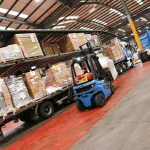
Wooden vs. Plastic Pallets: Which Is Better for Kenya’s Logistics Industry?
1. Introduction
Kenya’s logistics industry plays a crucial role in the country’s economy, supporting the transportation of goods across agriculture, manufacturing, retail, and export sectors. One essential component of efficient logistics is the pallet, which helps in the handling, storage, and movement of goods.
There has been an ongoing debate between wooden and plastic pallets, with businesses weighing the cost, durability, sustainability, and compliance factors before making a choice. But which is better suited for Kenya’s logistics industry? This article explores the advantages, disadvantages, and suitability of both wooden and plastic pallets to help businesses make informed decisions.
2. Understanding Pallets and Their Role in Logistics
What Are Pallets?
A pallet is a flat structure used as a base for stacking, storing, and transporting goods. It allows for efficient loading, unloading, and movement using forklifts, pallet jacks, and conveyor belts.
How Pallets Improve Supply Chain Efficiency
- Standardized packaging ensures better space utilization in warehouses and shipping containers.
- Reduced manual handling lowers labour costs and increases productivity.
- Minimized product damage enhances customer satisfaction and reduces losses.
Different Types of Pallets Used in Logistics
- Wooden Pallets – Made from hardwood or softwood and commonly used in various industries.
- Plastic Pallets – Made from high-density polyethylene (HDPE) or polypropylene (PP) and preferred for industries requiring hygiene and reusability.
3. Wooden Pallets: Characteristics and Advantages
Common Materials Used in Wooden Pallets
Wooden pallets in Kenya are often made from eucalyptus, pine, or cypress, which provide a balance of strength and affordability.
Advantages of Wooden Pallets
- Strength and Durability
- Can handle heavy loads, making them ideal for bulk shipments.
- Stronger than plastic pallets in certain load conditions.
- Cost-Effectiveness
- Lower initial cost compared to plastic pallets.
- Readily available materials in Kenya keep costs low.
- Eco-Friendliness and Recyclability
- Wooden pallets are biodegradable and recyclable.
- Damaged pallets can be repaired and reused multiple times.
4. Disadvantages of Wooden Pallets
1. Susceptibility to Pests and Contamination
- Wooden pallets can harbour insects, bacteria, and mould, which can affect food and pharmaceutical shipments.
- ISPM-15 treatment is required for export compliance, adding to costs.
2. Shorter Lifespan Compared to Plastic Pallets
- Wooden pallets wear out faster and have a higher breakage rate.
- More frequent replacements increase long-term costs.
3. Variability in Quality and Standards
- Differences in wood type and construction can affect strength and durability.
5. Plastic Pallets: Characteristics and Advantages
Common Materials Used in Plastic Pallets
- High-Density Polyethylene (HDPE) – Offers durability and resistance to impact.
- Polypropylene (PP) – More rigid and used for heavy-duty applications.
Advantages of Plastic Pallets
- Durability and Long Lifespan
- Plastic pallets can last 10+ years, reducing replacement costs.
- Resistance to Moisture, Pests, and Contamination
- Ideal for food, pharmaceutical, and hygiene-sensitive industries.
- Lightweight and Easy to Clean
- Lighter than wood, reducing freight costs.
- Can be sanitized, making them hygienic for medical and food use.
6. Disadvantages of Plastic Pallets
1. Higher Initial Cost
- Plastic pallets can cost 2-3 times more than wooden pallets, making them expensive for small businesses.
2. Environmental Concerns
- Plastic waste issues make disposal and recycling challenging.
3. Repairability Challenges
- Unlike wooden pallets, plastic pallets cannot be easily repaired when damaged.
7. Cost Comparison: Wooden vs. Plastic Pallets
| Factor | Wooden Pallets | Plastic Pallets |
|---|---|---|
| Initial Cost | Low | High |
| Lifespan | 3-5 years | 10+ years |
| Repairability | Easy and cheap | Difficult and costly |
| Hygiene | Requires treatment | Easy to clean |
| Sustainability | Biodegradable | Harder to recycle |
8. Environmental Impact: Which Pallet Is More Sustainable?
- Wooden Pallets – Require deforestation, but sustainable sourcing and recycling reduce environmental impact.
- Plastic Pallets – Last longer but contribute to plastic waste pollution.
9. Suitability for Different Industries in Kenya
| Industry | Best Pallet Choice | Reason |
|---|---|---|
| Agriculture & Food | Wooden | Cost-effective, widely used |
| Pharmaceuticals | Plastic | Hygienic and pest-resistant |
| Manufacturing | Wooden | Heavy-duty and cost-efficient |
| E-commerce & Retail | Plastic | Durable and lightweight |
10. Compliance with International Standards
- ISPM-15 certification required for wooden pallets in exports.
- Plastic pallets comply with strict hygiene regulations in the pharmaceutical and food industries.
11. The Future of Pallets in Kenya’s Logistics Industry
- Increased adoption of hybrid solutions (wooden pallets with plastic reinforcements).
- RFID tracking technology for pallet monitoring.
- Government policies promoting sustainability in pallet production.
12. Conclusion
Both wooden and plastic pallets have unique advantages and disadvantages. The choice depends on cost, industry needs, and sustainability goals.
Final Recommendation:
- For cost-conscious businesses – Wooden pallets remain the best choice.
- For industries requiring hygiene and durability – Plastic pallets are ideal.
Ultimately, Kenya’s logistics industry can benefit from a combination of both pallet types, ensuring efficiency and sustainability.





Add a comment